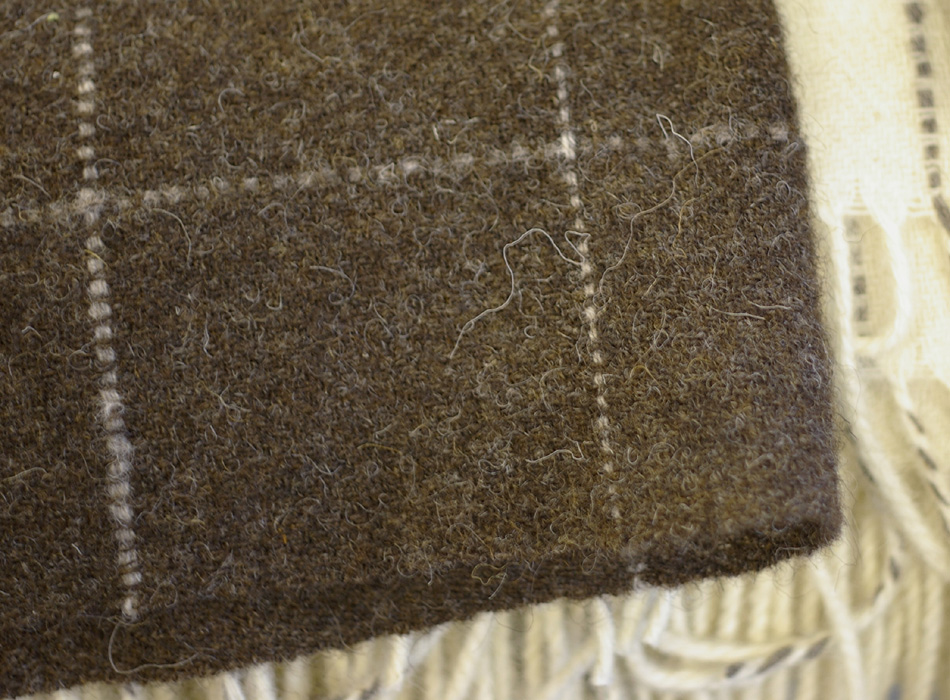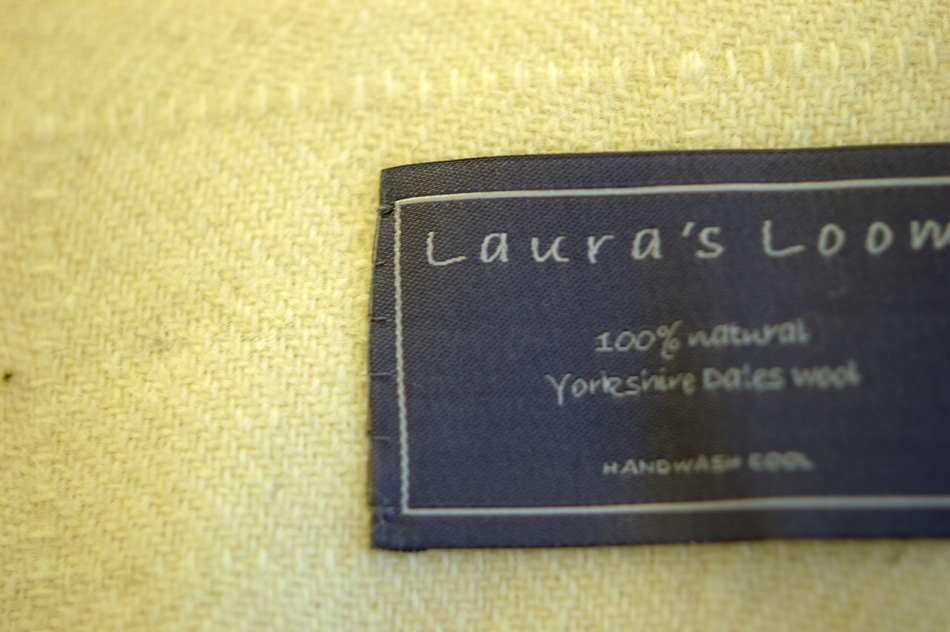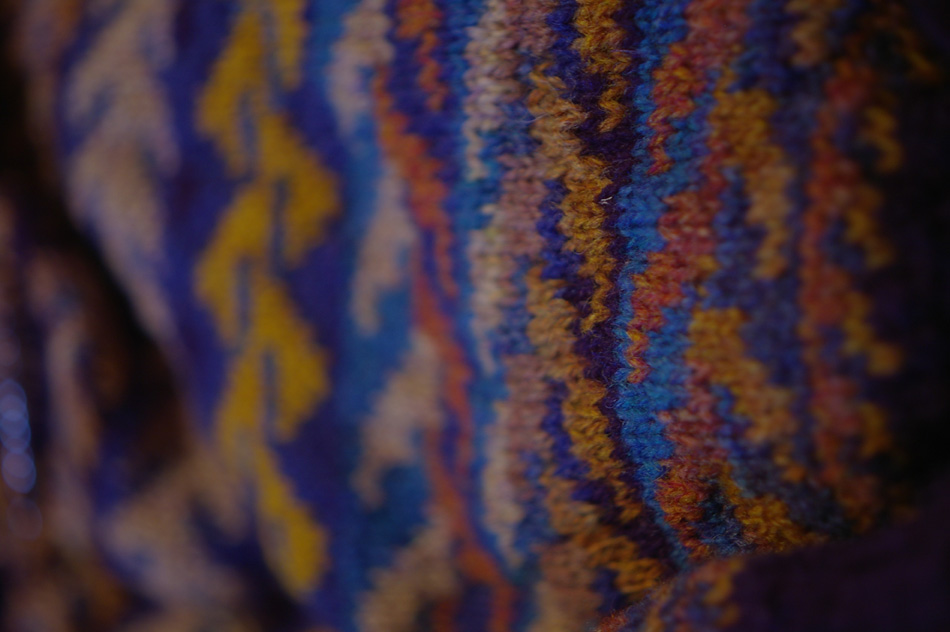The Domestic Soundscape making, listening, thinkingfelicityford@outlook.com
FO: Mairet
Wovember got me thinking in much more depth about weaving, because the history of wool in Britain is in fact not dominated by hand-knitting yarns, but by woollen cloth. Buying snippets of woollen fabric from eBay and local weavers in order to make Wovember badges, I became fascinated by the possibilities for texture, pattern, and colour inherent in the mysterious and alluring art of weaving.
This interest deepened my fascination for Ethel Mairet, (1872 – 1952) who was a weaver and dyer. You may recall from the Wovember blog that Mairet had some interesting things to say about synthetic fibres – namely that she felt it a shame that they were always forced to emulate natural fibres, rather than being developed as new kinds of textiles in their own right – but she also has some wonderful things to say about WOOL:
The production of wool in England has always been bound up with agriculture. The sheep has been an inherent part of the rotation of crops (just as the cow in Denmark). The climate is particularly suited to the breeding of sheep for wool – perhaps more so than in any other country. The equable climate, the varying types of land cultivation, and the varying soils, give a background which is very favourable to the breeding of different kinds of sheep. Violent changes and extremes of temperature are bad for the growth of fleece. A hardy, kempy outer wool with a soft inner wool is characteristic of sheep living in countries with extremes of heat and cold. An even humid temperature is needed for the production of the best fleece.
– Ethel Mairet, 1939, Hand Weaving To-Day
Mairet had a singularly modern attitude towards her craft. Throughout Hand Weaving To-Day she searches for a new place for hand-woven textiles, conceived in relation to industrial machinery, rather than in opposition to it. Ever-practical, she writes “it is not possible to go back to the days when hand-weaving supplied the needs of the people. A new orientation of the crafts must be found – a new idea of where they stand in relation to machinery.” Mairet also feels that all production processes must be inspired and informed by a thorough knowledge of the raw materials which they employ, and – in the case of textile production – seems to view hand-weaving as the principal activity for deriving such knowledge. She also links hand-weaving specifically to the practical needs of the age, insisting that hand-weaving need not be elevated to the status of an artform, but continually developed in relation to clothing and home-furnishings:
The essence of hand-weaving is in its continual creativeness and flexibility… based strictly on traditional knowledge. It is dependent on architecture and clothing; it must work in close collaboration with both. It cannot ever be an art by itself… for always it must be part of a building (curtains, rugs, hangings, etc.) or associated with the necessities of life (clothes, table-cloths, towels)…
– Ethel Mairet, 1939, Hand Weaving To-Day
I was reminded of the creativity, ingenuity and good sense of Mairet’s words when I travelled to Cumbria this January. In my journeys developing Hûrd – A KNITSONIK™ PRODUKTION, I met Laura Rosenzweig – who is a weaver – to discover how she has developed a range of blankets, scarves and throws using fleeces sourced directly from the Yorkshire Dales, the Lake District and the Scottish Highlands.
You may remember that I mentioned a few weeks ago the little Hebridean sheep of Windermere?
This fellow belongs to one of the flocks from which Laura gets wool with which to produce her range of Hebridean throws.
This gorgeous white blanket I think is one of the Dentdale Shawls woven from Bluefaced Leicester wool sourced from hill farms in the Yorkshire Dales. The wool is processed at small mills in West Yorkshire and woven at Drove Weaving in the Scottish Borders. Final finishing (washing and fringing) is carried out at Schofields in Galashiels.
…and this fabric is woven from locally-sourced wool collected from hill farmers in the Yorkshire Dales National Park, which is processed organically at small mills in Yorkshire. The darker shade is achieved through dyeing the wool. It is one of the Malhamdale Classic Scarves, and I love the beautiful texture created by those interweaving charcoal and white shades.
Laura’s approach to producing these tactile, evocative objects seems in many ways the embodiment of Mairet’s message about the relationship of hand-weaving to machinery; without the knowledge of materials and process gained through hand-weaving – and through her own experience of working with the Dobcross Loom at Farfield Mill – I wonder if it would be possible for Laura to work so fruitfully with industrial scouring plants, spinning mills, dyers and weavers, to produce the Howgill and Hebridean Collections? It was amazing to see the samples of wool-blends and yarns developed through Laura’s work with other folk in the weaving business, and her attention to detail and knowledge of materials is exacting and thorough. The results speak for themselves, and the objects she produces are beautiful, meaningful and useful. Perhaps – as Mairet argues – it is the in-depth knowledge of materials and the weaving process gathered through long hours of manual labour which endow one with the skill and the know-how to turn piles of dirty fleece into such things as scarves and blankets at a localised industrial level.
I also think that there is something in the concept of both the Howgill Range and the Hebridean Collection which would be hard to achieve without a deep appreciation for woolliness and the qualities of different Northern landscapes that have been specifically shaped by sheep. Laura said that developing these ranges was especially important to her; to make something from and about the places which she loves, in a material which is pertinent to such a task. Is there any more appropriate textile than WOOL when serenading the North of England?
Stone wall outside William Wordsworth’s cottage
To produce the The Hebridean collection, Laura “blended the Hebridean fleeces with Black Welsh, Moorit and Shetland wools to create a fabulous range of soft natural colours ranging from deep brown through mid-brown and grey-brown to silvery grey and natural ecru.” The range was originally inspired by a place in the Highlands which she visited, a fact echoed in the names of the yarns – which are all derived from places in the Highlands or the outer-Hebrides. This misty, grey yarn is called “St Kilda.” Laura has not been there, but the primitive breeds of sheep from which much of the Hebridean Collection is derived originate from those mysterious isles, and the Black Hebrideans of Windermere were originally known as “St Kildas.”
As well as her appropriate use of WOOL to celebrate her fabourite landscapes, Laura’s employment of synthetic textilres reminds me of Mairet’s wise words. Some of Laura’s hand-weaving makes specific use of the non-shrinking properties non-woolly fibres combined with wool. When the resulting fabric is thrown into a washing-machine, non-woolly chenille yarns retain their structure while – according to the pattern in which the fibres have been organised – the woolly sections in the design felt and shrink, creating puckered, bubbly surfaces which look to my enthusiastic eyes very much like the “new textile expressions” sought by Mairet in 1939:
The new synthetic raw materials have mostly been used for copying the natural raw materials. This is as much a setback in the development of the textile art as the copying of Gothic is to architecture. New conditions require a new expression and we still have to find this new textile expression.
– Ethel Mairet, 1939, Hand Weaving To-Day
Suffice to say, inspired by Mairet’s words of 1939 and Laura’s amazing textiles of 2012, I set about finding my own textile expression, and since I cannot weave but I can knit, I made this.
It is a scarf, based on a slip-stitch pattern, using 3 natural sheep-fleece shades of yarn.
The dark grey colour is Jarol’s 100% Pure British Wool; the mid-grey colour is some Aran weight North Ronaldsay which is now sadly quite difficult to get hold of (though I think this would be excellent substitutes) and the white colour is a natural Blue Faced Leicester wool, spun by the Natural Fibre Company for Caecilia and Jan of the The Woolclip.
If you haven’t tried slip-stitch or mosaic knitting, I think it is a very pleasing way to begin working with multiple colours, as you only ever have one shade in your hands at any one time. Slipping the stitches – i.e. not knitting some of the stitches on some rows, and knitting them on others – reminds me of the selective way that yarn travels over and under the warp stitches in the act of weaving, according to how the shed is raised or lowered during the process.
Barbara Walker calls this stitch pattern “dice pattern,” but to me it looks like gingham or a kind of plaid.
I found it much neater to pick up my border from one stitch in, rather than on the very edge of the work. This results in a selvedge, which is easily and neatly whip-stitched flat to the back of the work. The strands at the back make a soft, cushy fabric which holds the heat in nicely. I wrote up the pattern and I called it Mairet, because of the inspiration around weaving and wool which Ethel Mairet’s book has given me, lately. The instructions are available to buy here. I have deliberately separated the massive images from the text, so as to save on printer ink should you wish to print it out.
Project Specs:
Pattern design: ‘Mairet’ by Felicity Ford
Yarn: assorted 100% British Wool Yarns in Aran weight, in dark and mid grey, and natural white
Needles: 4mm 80cm circ and 3.25mm 120cm circular needle
Ravelled: here
…As for Harefields, I have not yet got a hat pattern for you, but I do have a swatch-in-progress! Who knew there were so many ways to express the idea of “wheat” in fairisle?














Pingback: Press | Lauras Loom